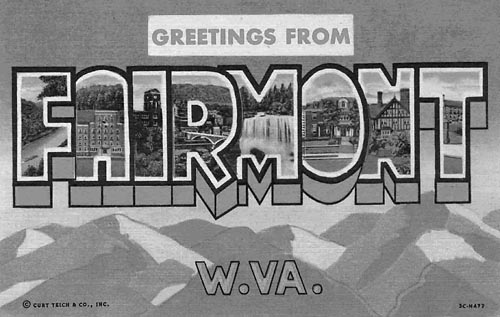The View from Fairmont
A Century in Postcards
By Raymond Alvarez

Fairmont postcard from about 1910
For more than a century, postcards have offered an inexpensive way to send greetings, coupled with an interesting or picturesque image frozen in time. Deltiology is the formal name for postcard collecting, estimated to be the third most popular collectible hobby in the world, following coins and stamps. With a fairly inexpensive purchase price today - generally less than $7 for a postmarked card - this hobby continues to grow in popularity. Here in West Virginia, collectors naturally stay on the lookout for postcards showing the beauty and history of cities and towns in the Mountain State.
Postcards have a long and interesting history of their own, however. The first copyright for private, non-pictorial cards used for advertising purposes was obtained in 1861. In 1873, the U.S. government issued its first postal cards, but it was not until the Chicago World's Columbian Exposition in 1893, when full-color postcards were sold as souvenirs, that the popularity of postcards began to grow.
Congress authorized private publishing in 1898, and postcards were soon mass-produced and mailed throughout the world. Writing was not permitted on the address side at the time, but enough of a blank area remained on the other side around the image for a sender's terse message. By 1907, postcards with a divided back were permitted. The address and message could now be written on the same side, allowing the image to take up the entire front of the card. The new Rural Free Delivery system helped make sending postcards practical and affordable, and they quickly became a way of life in the United States, including here in West Virginia.
Many early cards were imported from Germany, where the lithography process was advanced. When World War I cut off the supply of the German postcards, American printing technology and photography advancements fostered local production and a greater availability of local cards. Postcards were soon sold inexpensively in shops, hotels, and newsstands, as well as in post offices around the country.
Most early postcards featured sepia-toned or black-and-white photographic images. Hand-tinting these cards provided steady work for countless local artists, though the coloration process sometimes muted the sharpness or detail of the original photographs. From 1916 to 1930, postcards featured sharper colors and a distinctive white border. By 1930, the linen card became the standard, characterized by high rag content in the paper stock, which gave the surface a textured feel. Photochrome cards achieved popularity in the late 1940's, with clearer, glossy images printed on smooth paper.
The attraction of the postcard was often the photo subject itself. Leafy Main Street scenes, grand homes, local scenic spots, the highest peak, or other important locations were featured on cards from most any town in America during the early 20th century. It is nearly impossible to estimate the number of images that have appeared on postcards featuring West Virginia views. Scenes of Fairmont are no exception
You can read the rest of this article in the Fall 2003 issue of Goldenseal, available in bookstores, libraries or direct from Goldenseal.